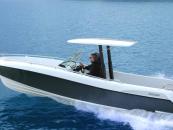Rob Denney has been building and playing with boats for decades, but he still vividly remembers the day he was sitting on an offshore cat, hanging over the windward rail and thinking, “Is this the best way to do it? Surely there’s a better way.” That was the kernel of the idea that grew into the reversible Harryproa multihulls that sail using shunting, rather than tacking and gybing.
What exactly is the shunting sailing method? Shunting is an alternative type of sailing used by proa boats. A proa has two hulls – one long, one short. The short one is always windward, with all the weight in it. In a shunt, both the rig and the rudder rotate 180 degrees while the boat sails off in the other direction. The bow then becomes the stern. It is a similar technique to the one used by kite surfers.
Rob explained some of the benefits of shunting. “On a proa, it’s a little slower than tacking and gybing. But it’s much, much safer, especially in strong breezes. You don’t go out of control and have to bang the main across in a gybe. Normally when you’re tacking in big waves, you need enough sail area to carry the boat around, which means you need a lot of sail up. Whereas on a proa, you can have just enough sail up to keep you moving, and so shunting is easy. Sailing in strong winds and big waves is much easier and less stressful.”
Rob told us that, although has has been building his Harryproas for over a decade, it may never have happened if it was not for his wife, Sue. “Fifteen years ago I was enjoying a couple of wines with my wife on a nice sunny day, and she said, ‘You should build a boat.’ And I said, ‘You’re right. I must do.’ She went on to list a few requirements it needed: it was not allowed to cost much money; it had to be one that wouldn’t make her seasick; and, it had to be something that was easy to sail. She loves being on the water, but doesn’t like the hard work, so it needed minimum of strings. That was basically the first Harryproa I built, which did all that. It looked rough as guts, but it worked and didn’t make Sue sick. All the weight was concentrated in the middle so it didn’t pitch much. The motion was nice, and it just had one string to pull for the sail. Shunting is effortless compared to tacking, so she was happy.”
While Rob just built the first Harryproa for himself and his wife to enjoy, fellow sailors soon saw the benefits and wanted one. So his business grew from there. Over the last decade, he has been refining the building process, which is contained in the plans he sells. “We’ve been developing a new build method called Intelligent Infusion that is very easy, very clean and very cheap. You build a cheap mould out of MDF, throw a couple of coats of paint on it to make it airtight, then you put all the laminate in it dry, and it’s all flat panels. All the tricky bits, like window rebates and strong points are included in the infusion. It all gets put in a bag, the air is sucked out and the resin goes in. After 40 minutes, you have half a hull built. It takes a couple of days to put it all in, but that’s clean and easy work. The infused laminate is half the weight of a handmade one, and there’s no stickiness, and no dust. It’s at the stage where it’s the smartest way to build a boat.”
Understandably, Rob has been swamped by orders for his Harryproa plans because of the number of advantages they offer over traditional cats. Not only are they easier to build, but they also come in at a tiny fraction of the cost. The plans cost $3,000 to $4,000. The material costs are about half that of cats and tris of the same length. And the build cost is around $50,000 for a 12m-race version.
The ease of shunting means the Harryproas can be crewed effortlessly with two people. And it can even be done solo, if you prefer. For these reasons, new Harryproa owners are popping up around the world, with many 50- and 60-footers being built in Australia.
Rob explained how friendly the proa community is. “Everyone we’ve sold plans to has become a friend because there’s so much email going back and forth. I get on really well with all of my clients, and we’re always ready to take each other out for a sail.”
For more information, contact Rob at harryproa@gmail.com or visit www.harryproa.com.
By Narayan Pattison
(May-Aug2017)



























